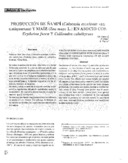Producción de ñampí (Colocasia esculenta var. antiquorum) y maíz (Zea Mays L.) en asocio con Erythina fusca y Calliandra calothyrsus
Alternative title
Yields of eddo (Colocasia esculenta) and maize (Zea mays) in association with Erythrina fusca y fusca and Calliandra calothyrsus in an alley farming system
Description
3 ilus. 1 tab. 9 ref. 6 pág.
Abstract
Se evaluó la producción de maíz (Zea mays L.) y ñampí (Colocasia esculenta L.), con un ciclo por año de cada uno, en un cultivo en callejones con Calliandra caloathyrsus y Erythrina fusca (2podas/año) establecidos a 6 m por 0.5, 1 y 2 m. en el ñampí se evaluaron el peso y número de los cormelidos comerciales y totales en maíz el peso seco del grano y la biomasa vegetativa y en los árboles la biomasa de las podas. En maíz y ñampí, a partir de la segunda cosecha, se observó la superioridad del asocio con árboles versus el monocultivo. En maíz en la tercera cosecha, E. fusca fue superior que C. calothyrsus. Se concluye que ñampí tiene potencial para ser cultivado en asociación con árboles. Sin embargo, la biomasa de los árboles no satisface los requerimientos nutricionales del cultivo. Production of maize (Zea mays L.) and eddo (Colocasia esculenta L.), one harvest of each crop per year, were evaluated in an alley farming system with Calliandra calothyrsus and Erythrina fusca, planted in rows 6m wide with spacings of 0.5, 1 and 2m between trees and pruned twice yearly. For eddoes and maize, weight and number of commercial and total corns were evaluated for maize, dry weight of harvested grain, and for the trees, biomass production. For eddoes and maize, starting at second harvest, yields in alley farming were greater than in monoculture in the third harvest, maize yields were greater with E. fusca than with C. calothyrsus. It was concluded that there is potential to cultivate eddoes in association with trees although biomass production was insufficient to meet nutrient needs.
Keywords
Publisher
CATIE, Turrialba (Costa Rica)


